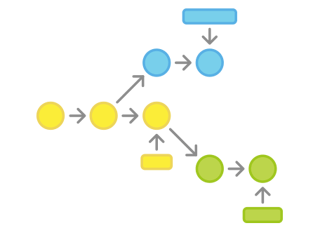
The IP development process can be drawn out over dozens of months, while on other occasions it can be accelerated to a few weeks. Although the timeframe may vary, there are a few core milestones in the innovation workflow that will always be met in order to give inventions life, protection, and profitability. Here are the seven steps that businesses must follow in order to successfully convert their ideas to proprietary assets, and some recommendations on how your company can accomplish those steps.
1) Conception
Every invention begins with an idea, one that is borne of the mission to solve some problem in the world or within an organization. When building an innovation workflow, it’s important to acknowledge this first step, as it will partially determine the success of the remainder of the process. You can empower your employees by giving them creative freedom and encouragement to contribute to challenges in the workplace, with your products, or in your industry as a whole — just make sure they’re aware of how they should share their solutions once they have them. Point out who they should present concepts to, how they should be reported, and why it’s valuable to log their approved concepts into IP management software, if possible.
2) Documentation
After developing the figurative “outline” of an invention, you’ll need to fill in the details and give it a proper shape. Supporting assets like figures and schematic drawings, procedural manuals, and additional descriptions of the intended uses do more than just facilitate the invention disclosure process. In most cases, these details are required to get your invention patented. Your documentation should demonstrate how it is different from other IP that came before it, and give others reason to believe it’s actually possible to create in the end.
3) Arrange and Issue NDAs
If nondisclosure and invention assignment agreements did not occur at the inception of an employee, contractor or partner relationship, this step occurs somewhat in tandem with documentation, since any written evidence of the invention can give others a way to replicate it. Anyone involved on the project — the person who developed the concept, managers in charge of approval, and any collaborators working on making the invention a reality should execute a nondisclosure agreement (NDA) to protect the IP prior to its official protection by the United States Patent and Trademark Office (USPTO). Legal personnel, particularly patent attorneys, can help you create these NDAs. It may seem like a hassle, but if you include NDAs as just another part of the innovation workflow, it will speed up the process and reduce some of the risks of misappropriation.
4) Perform Due Diligence & Patent Searching
By this point your team has already gathered or created some documentation that effectively describes your invention’s purpose and defining features. To ultimately get your invention approved, you must show that your idea is original, or at least an original improvement on a past invention. Looking back into patent archives for prior art and other related inventions will help you support that originality and get your new invention past the approval process. A patent attorney can help you with the patent search process. Once any related material is found, it should be attached in your invention’s portfolio.
5) Submit Patent Application
As far as legal protection of your new IP goes, this is one of the final steps. With all of the information describing and differentiating your invention, you can submit your patent application. Application costs will vary based on application type and if any rush processing is required. Regardless of whether the application has a rush order, review by the USPTO takes multiple weeks or months. Once you check off this crucial step in the innovation workflow, however, you’re ready to turn what was once an idea into a protected asset.
6) Manufacturing
While this manufacturing step can of course refer to the development of your market-ready product, manufacturing may also play a role earlier in the IP development process. Having a working prototype will assist you in in developing a more accurate description along with your patent application, so there are fewer questions about the originality of its design and function. Fewer questions make for an expedient review, i.e. a shorter time to market launch and sales.
7) Explore Options for Revenue
While your patent is placed under review, or once it is granted patent protection, you have a few options in front of you for turning a profit from your investment in the innovation process. Product development and sale are likely at the top of your list, but as time goes on, you may find yourself holding onto outdated patents that are only adding to the net cost of your portfolio. You also may have developed a patent for a technology that isn’t directly related to your organization’s ultimate product strategy. For those cases, you can either sell off your patent to another organization, or license it to a third party.
When you nail down your innovation workflow process, developing new IP and making it profitable becomes second nature to your team. Preparing that process and turning it into something tangible can take a lot of time, but IP management software like Decipher® already has the framework in place to implement an efficient workflow. Decipher also facilitates rapid communication to further streamline your innovation steps. To learn more about why IP management software is integrated into enterprise businesses around the globe, click here to download the Decipher product sheet now.


